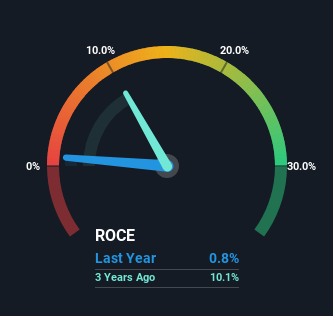- China
- /
- Tech Hardware
- /
- SZSE:000977
Returns On Capital Signal Tricky Times Ahead For Inspur Electronic Information Industry (SZSE:000977)

If we want to find a potential multi-bagger, often there are underlying trends that can provide clues. Firstly, we'll want to see a proven return on capital employed (ROCE) that is increasing, and secondly, an expanding base of capital employed. Put simply, these types of businesses are compounding machines, meaning they are continually reinvesting their earnings at ever-higher rates of return. Although, when we looked at Inspur Electronic Information Industry (SZSE:000977), it didn't seem to tick all of these boxes.
What Is Return On Capital Employed (ROCE)?
Just to clarify if you're unsure, ROCE is a metric for evaluating how much pre-tax income (in percentage terms) a company earns on the capital invested in its business. Analysts use this formula to calculate it for Inspur Electronic Information Industry:
Return on Capital Employed = Earnings Before Interest and Tax (EBIT) ÷ (Total Assets - Current Liabilities)
0.0079 = CN¥228m ÷ (CN¥52b - CN¥23b) (Based on the trailing twelve months to September 2023).
Therefore, Inspur Electronic Information Industry has an ROCE of 0.8%. Ultimately, that's a low return and it under-performs the Tech industry average of 5.9%.
See our latest analysis for Inspur Electronic Information Industry

Above you can see how the current ROCE for Inspur Electronic Information Industry compares to its prior returns on capital, but there's only so much you can tell from the past. If you'd like, you can check out the forecasts from the analysts covering Inspur Electronic Information Industry for free.
What Does the ROCE Trend For Inspur Electronic Information Industry Tell Us?
On the surface, the trend of ROCE at Inspur Electronic Information Industry doesn't inspire confidence. Around five years ago the returns on capital were 11%, but since then they've fallen to 0.8%. Given the business is employing more capital while revenue has slipped, this is a bit concerning. If this were to continue, you might be looking at a company that is trying to reinvest for growth but is actually losing market share since sales haven't increased.
On a related note, Inspur Electronic Information Industry has decreased its current liabilities to 44% of total assets. So we could link some of this to the decrease in ROCE. What's more, this can reduce some aspects of risk to the business because now the company's suppliers or short-term creditors are funding less of its operations. Some would claim this reduces the business' efficiency at generating ROCE since it is now funding more of the operations with its own money. Keep in mind 44% is still pretty high, so those risks are still somewhat prevalent.
What We Can Learn From Inspur Electronic Information Industry's ROCE
In summary, we're somewhat concerned by Inspur Electronic Information Industry's diminishing returns on increasing amounts of capital. However the stock has delivered a 84% return to shareholders over the last five years, so investors might be expecting the trends to turn around. Regardless, we don't feel too comfortable with the fundamentals so we'd be steering clear of this stock for now.
On a final note, we found 3 warning signs for Inspur Electronic Information Industry (1 is significant) you should be aware of.
If you want to search for solid companies with great earnings, check out this free list of companies with good balance sheets and impressive returns on equity.
New: AI Stock Screener & Alerts
Our new AI Stock Screener scans the market every day to uncover opportunities.
• Dividend Powerhouses (3%+ Yield)
• Undervalued Small Caps with Insider Buying
• High growth Tech and AI Companies
Or build your own from over 50 metrics.
Have feedback on this article? Concerned about the content? Get in touch with us directly. Alternatively, email editorial-team (at) simplywallst.com.
This article by Simply Wall St is general in nature. We provide commentary based on historical data and analyst forecasts only using an unbiased methodology and our articles are not intended to be financial advice. It does not constitute a recommendation to buy or sell any stock, and does not take account of your objectives, or your financial situation. We aim to bring you long-term focused analysis driven by fundamental data. Note that our analysis may not factor in the latest price-sensitive company announcements or qualitative material. Simply Wall St has no position in any stocks mentioned.
About SZSE:000977
Inspur Electronic Information Industry
Inspur Electronic Information Industry Co., Ltd.
Proven track record with mediocre balance sheet.


